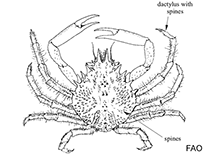Jacquinotia edwardsii (Jacquinot, 1853)
Southern spider crab
Upload your photos
Google image | No image available for this species;
drawing shows typical species in Majidae.
Google image | No image available for this species;
drawing shows typical species in Majidae.
Classification / Names Common names | Synonyms | CoL | ITIS | WoRMS
Malacostraca | Decapoda | Majidae
Environment: milieu / climate zone / depth range / distribution range Ecology
Benthic; depth range 4 - 549 m (Ref. 78781). Subtropical; 35°S - 55°S, 164°E - 175°W (Ref. 78779)
Distribution Countries | FAO areas | Ecosystems | Occurrences | Introductions
Southwest Pacific: New Zealand. Temperate to subtropical.
Length at first maturity / Size / Weight / Age
Maturity: Lm ?, range 10 - ? cm Max length : 20.0 cm CW male/unsexed; (Ref. 126800)
Maximum depth based on occurrence in the Snares Island, New Zealand (Ref. 78779). Species is found also in intertidal areas. Minimum depth range from Ref. 121895. Total length (including spreadout legs) may reach 1 m (Ref. 126800). Coastal waters (Ref. 121899). Found in shallow waters, at depths of 4 to 5 m (Ref. 121895). Intertidal to offshore waters, sometimes extending up to 549 m. Common in rock pools among seaweed or on sandy beaches (Ref. 78781).
Life cycle and mating behavior Maturity | Reproduction | Spawning | Eggs | Fecundity | Larvae
Members of the order Decapoda are mostly gonochoric. Mating behavior: Precopulatory courtship ritual is common (through olfactory and tactile cues); usually indirect sperm transfer.
Main reference
References | Coordinator | Collaborators
Fenwick, G.D. 1978. (Ref. 78779)
IUCN Red List Status (Ref. 130435)
CITES status (Ref. 108899)
Not Evaluated
CMS (Ref. 116361)
Not Evaluated
Threat to humans
Harmless
Human uses
Fisheries: commercial
| FishSource | Sea Around Us
Tools
More information
Internet sources
BHL | BOLD Systems | CISTI | DiscoverLife | FAO(Publication : search) | Fishipedia | GenBank (genome, nucleotide) | GloBI | Gomexsi | Google Books | Google Scholar | Google | PubMed | Tree of Life | Wikipedia (Go, Search) | Zoological Record
Estimates based on models
Preferred temperature
(Ref. 115969): 7.6 - 10.9, mean 9.3 (based on 5 cells).



